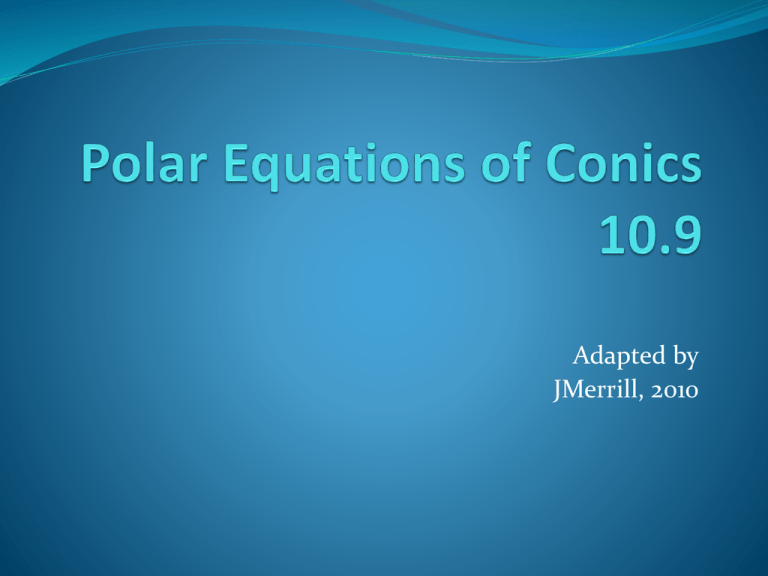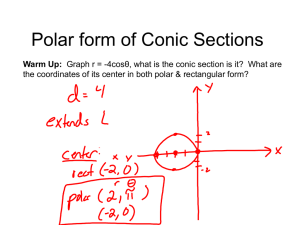
Adapted by
JMerrill, 2010
Alternative Definition of a Conic:
The locus of a point in the plane which moves so
that its distance from a fixed point (focus) is in a
constant ratio to its distance from a fixed line
(directrix) is a conic. The constant ratio is the
eccentricity (or measure of the flatness) of the
conic and is denoted by e.
2
F = (0, 0)
0
LocusP
Q
Copyright © by Houghton
Mifflin Company, Inc. All rights
reserved.
2
Directri
x
Ellipse
2
Q
P
Directri
x
0
F = (0, 0)
e PF 1
PQ
Copyright © by Houghton
Mifflin Company, Inc. All rights
reserved.
3
Ellipse
Parabola
2
Q
P
Directri
x
0
F = (0, 0)
e PF 1
PQ
Copyright © by Houghton
Mifflin Company, Inc. All rights
reserved.
4
Parabola
Directri
x
Hyperbola
Q
P
2
P
F = (0, 0)
0
Q
e PF PF 1
PQ PQ
Copyright © by Houghton
Mifflin Company, Inc. All rights
reserved.
5
Hyperbola
Polar Equations of Conics:
The graph of a polar equation of the form
r
ep
1 e cos
Vertical directrix
or
ep
r
1 e sin
is a conic, where e > 0 is
the eccentricity and |p| is
the distance between the
focus (pole) and the
directrix.
Horizontal directrix
2
F = (0, 0)
0
P
Q
Copyright © by Houghton
Mifflin Company, Inc. All rights
reserved.
6
| p|
Directri
x
Example:
Identify the type of conic represented by the
equation
r
6 .
2 sin
3
1 1 sin
2
Divide the numerator and denominator by 2 to
rewrite in the form
e 1 1
2
ep 6
r
p 12
The graph is an ellipse with a distance of 12
between the pole and the directrix.
Copyright © by Houghton
Mifflin Company, Inc. All rights
reserved.
7
ep
.
1 e sin
Graphing Utility: Graph the conic given by the
6 .
equation
r
2 sin
Mode Menu:
Set to polar mode.
6
–6
6
–6
The graph is an ellipse with a distance of 12 between the pole and the
directrix.
Copyright © by Houghton Mifflin Company, Inc. All rights reserved.
8
If p is the distance between the directrix and the
pole, then one of the following four formulas will
be used to find the polar equation for the conic
1. Horizontal directrix above the pole:
r
ep
1 e sin
2. Horizontal directrix below the pole:
r
ep
1 e sin
3. Vertical directrix to the right of the pole:
r
ep
1 e cos
4. Vertical directrix to the left of the pole:
r
ep
1 e cos
Copyright © by Houghton
Mifflin Company, Inc. All rights
reserved.
9
Example:
Analyze the graph of the polar equation r
r
32 .
3 5sin
32
3 5sin
32 / 3
3 / 3 5 / 3 sin
Divide the numerator and
denominator by 3.
32 / 3
1 5 / 3 sin
Because e 5 1,
3
the graph is a hyperbola.
The transverse (vertical) axis lies on the line 2.
Copyright © by Houghton
Mifflin Company, Inc. All rights
reserved.
10
Example continues.
Example continued:
32
r
3 5sin
The vertices occur at (r, ) (4, 2) and (r, ) (16, 2).
24
Use trace to find the vertices
16, 2
4,
2
– 18
24
–4
Copyright © by Houghton
Mifflin Company, Inc. All rights
reserved.
11
Example:
Find the polar equation of the parabola whose focus
is the pole and whose directrix is y = – 4.
y
The directrix is horizontal and
below the pole.
ep
r
1 e sin
1p
1 1sin
r
4
1 sin
Copyright © by Houghton
Mifflin Company, Inc. All rights
reserved.
12
8
parabola
4
e=1
x
-4
4
p4


